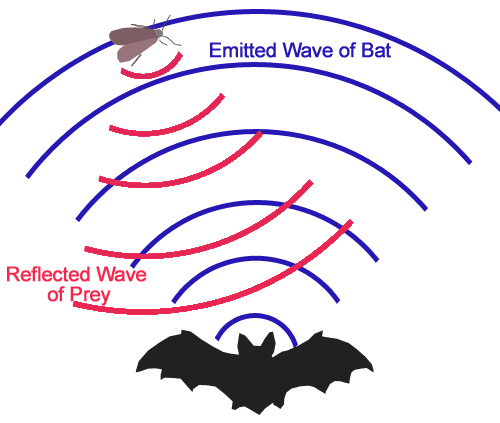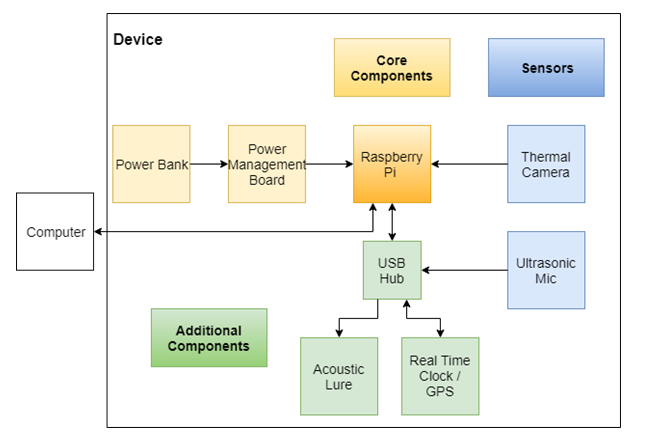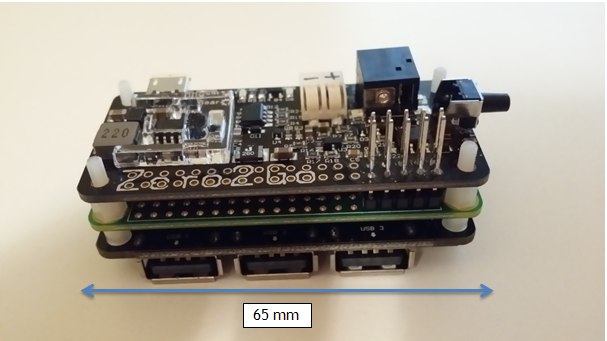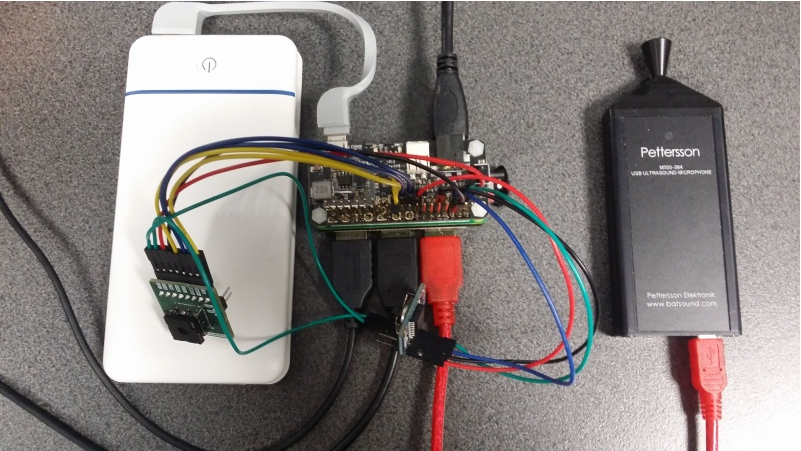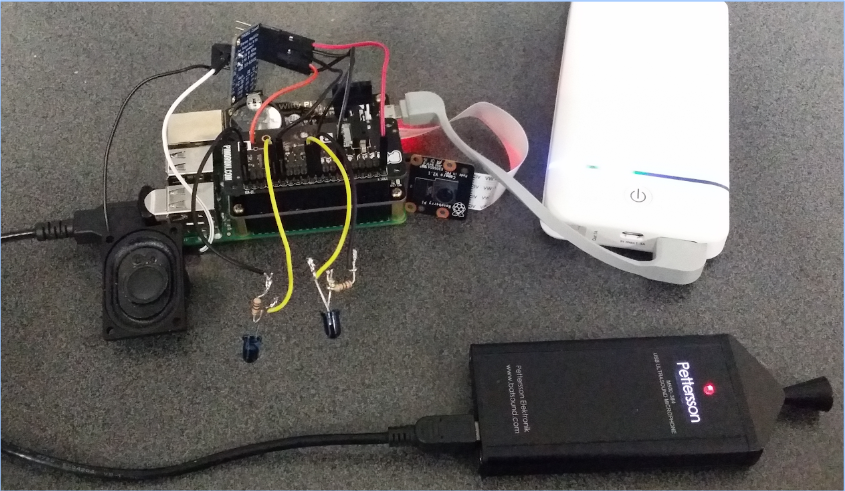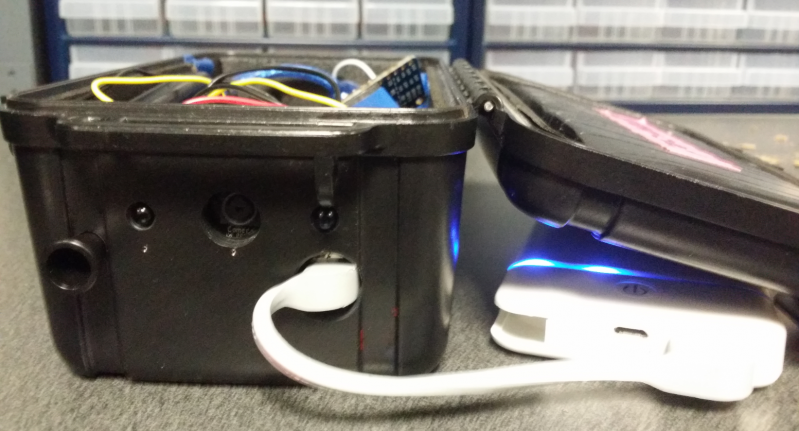Difference between revisions of "Projects:2018s1-151 Raspberry Pi as a Core Device for Efficient Biological Field Survey Data Collection"
| (12 intermediate revisions by the same user not shown) | |||
| Line 1: | Line 1: | ||
| − | |||
'''''Introduction''''' | '''''Introduction''''' | ||
---- | ---- | ||
| Line 41: | Line 40: | ||
'''''Introduction''''' | '''''Introduction''''' | ||
---- | ---- | ||
| − | Data collection on biodiversity field surveys in today’s world is reliant increasingly on the use of electronic devices that are both expensive and can only record one form of data. There are multitudes of devices which sense and measure aspects of the abiotic environment, such as water chemistry and atmospheric conditions [ | + | Data collection on biodiversity field surveys in today’s world is reliant increasingly on the use of electronic devices that are both expensive and can only record one form of data. There are multitudes of devices which sense and measure aspects of the abiotic environment, such as water chemistry and atmospheric conditions [1], as well as animals themselves through photographic [2], video [3] or acoustic recordings [4]. The hardware developed for various types of data collection has been established in the marketplace for years, however because these devices are highly specialised for particular tasks and markets they are typically highly priced for a good quality product [5]. |
| − | Such high quality specialist devices are often out of the reach of scientists in developing countries, especially when multiple units are required for robust levels of site replication [ | + | Such high quality specialist devices are often out of the reach of scientists in developing countries, especially when multiple units are required for robust levels of site replication [6]. However, with the increasing miniaturisation of electronic components, development of processing power, cost efficiency of flash memory storage and the availability of low-cost hobby electronics, there appears to be increased opportunity for the consumer-led development of customised devices [7]. |
'''''Bat echolocation''''' | '''''Bat echolocation''''' | ||
---- | ---- | ||
| − | Through the use of ultrasonic echolocation calls, bats are able to efficiently forage at night. This echolocation involves the bat sending out a call at very high frequency pulses, which in turn bounces off any objects in its vicinity. The bat then focuses on the location of the reflected wave to zero in on its insect prey, or avoid an obstacle [ | + | Through the use of ultrasonic echolocation calls, bats are able to efficiently forage at night. This echolocation involves the bat sending out a call at very high frequency pulses, which in turn bounces off any objects in its vicinity. The bat then focuses on the location of the reflected wave to zero in on its insect prey, or avoid an obstacle [8]. |
| + | |||
| + | As different bats echolocate at different frequencies depending on their body size and feeding habitat, it is possible to identify these bats through the examination of echolocation calls [8]. Recordings can be subjected to a range of different signal processing options to allow visualisation and classification of the calls. These devices are known as ultrasonic bat detectors and are one of the main components that will be implemented through the completion of this project. | ||
| + | |||
| + | [[File:Bat_echolocation.png]] | ||
| + | |||
| + | '''''Method''''' | ||
| + | ---- | ||
| + | The core device integral to the completion of the project is the Raspberry Pi Zero. For its successful use in the project, various enhancements have to be considered including Wi-Fi connectivity, time management capabilities, storage of data and efficient power management. The Raspberry Pi Zero (RPi) also acts as an inexpensive but highly flexible miniaturised UNIX computer core from which a number of external sensors and components can be attached. To consider both the internal components as well as all the external functionality, a general system overview has been proposed. | ||
| + | |||
| + | [[File:BlockDiagram.PNG]] | ||
| + | |||
| + | Completing the core system functionality was done through the addition of a number of important components. Firstly, the Zero2Go power management board was soldered and screwed on top of the RPi Zero to provide safety to the system from compromises in the power bank connection (i.e, power bank suddenly turns off, or cable disconnected). The Zero2Go also contains a simple tap-on/tap-off switch for turning the RPi safely on and off. The Zero 4U was screwed on the bottom of the board to provide a means to attached more USB connected components to the system, such as a keyboard, mouse, wireless USB receiver and the Pettersson microphone. A picture of this core system is provided below. | ||
| + | |||
| + | [[File:Core_system.png]] | ||
| + | |||
| + | With the core system complete, further modules could be added to the system to improve functionality. Firstly, an acoustic lure was implemented through the use of a Pimoroni PHAT DAC, providing 16 bit Digital-to-Analog conversion for higher audio quality. An Adafruit TPA2012 Class D audio amplifier was than attached to increase the decibel levels of any audio input, through variable gain settings. Finally a multitude of mini speakers were bought and integrated to the system. While all slightly different in design and specification, they were all moving coil speakers, with a minimal size (mini speakers) so as to best suit the needs of the project. By testing the amplifiers and speakers, the most suitable components could be used depending on decibel level, frequency response, power consumption and efficiency. | ||
| + | |||
| + | With the acoustic lure in place, another additional component that could be considered was the FLIR Lepton 3.5 thermal imaging camera. This allows for heat mapping, telemetry and thermal video capture in an outdoor capacity. With a resolution of 160 x 120 active pixels, a low operating power of 140mW and with small dimensions (11.8 mm x 12.7 mm x 7.2 mm) [59], the FLIR lepton 3 camera was optimal for use in this project. It is also relatively inexpensive in comparison with other leading thermal imaging cameras, listed on the Element14 web store at a price of 377.3 AUD [60]. To hookup the FLIR, the RTC (real time clock) first had to be hooked up, and the FLIR had a daisy-chain connection to the device via the SDA and SDL pins on the RTC. | ||
| + | |||
| + | [[File:FLIR-daisy2.PNG]] | ||
| + | |||
| + | However, a problem was ran into with this configuration, as it was found that the Raspberry Pi zero was not able to produce any sort of video live feed from the FLIR Lepton via the Video-over-SPI (VoSPI) connections. A number of problems may have occurred, firstly that the software libraries had not been updated to suit the newest version of the Raspberry Pi Zero and FLIR Lepton 3.5. Secondly, there could have been issues with frame synchronisation. Finally, there may have been problems with other software programs interfering with the FLIR Lepton and causing the lack of video feed. | ||
| + | |||
| + | Due to the slow computational power of the raspberry pi zero, and the lack of forward success with the incorporation of all the system elements, the decision was made to change the core to a Raspberry Pi 3B. | ||
| + | With more robust specifications, including a quad-core 1.2 GHz processor, 1GB RAM and a 400 MHz Dual Core Video Core IV GPU, proving pivotal in ensuring that all the various tasks performed by the device are recorded and stored in a quick and timely manner. | ||
| + | |||
| + | [[File:Final-System.PNG]] | ||
| + | |||
| + | With the final system put together, there was only the issue of how it was going to be packaged. Through the use of a large ABS Case from Duratech, which is able to provide waterproofing, this issue was resolved. By using a glue gun, drilling holes for the sensors and cable management, the final system could be contained effectively and safely within the case. | ||
| + | |||
| + | [[File:Cased system.png]] | ||
| + | |||
| + | '''''Conclusion''''' | ||
| + | ---- | ||
| + | The project demonstrates how professional-grade but low-cost specialised scientific devices can be built from an increasing availability of both hobbyist parts and high-quality components. The modularity of the design is unique and allows the user to add or remove capability as required. Most parts are “plug and play”, allowing users to switch out a speaker, Amplifier or even the ultrasonic microphone. Design modularity also gives users options in terms of total overall cost. | ||
| + | |||
| + | The project successfully assembled and tested an acoustic lure, the Raspberry Pi NOIR infrared-capable camera element, and the Pettersson Elektronik M500-385 ultrasonic bat detector. Further work is required to successfully integrate the FLIR Lepton 3.5 thermal camera element, as current video capturing capabilities have not been documented over the Raspberry Pi GPIO SPI interface. | ||
| + | |||
| + | '''''Future Work''''' | ||
| + | ---- | ||
| + | 1) Increasing efficiency by decreasing power consumption of non-essential RPi processes to allow for longer field deployment times | ||
| + | |||
| + | 2) Introduction of additional sensors to characterise the ambient environment, such as humidity, temperature, location, and motion sensing | ||
| + | |||
| + | 3) Given that components are evolving rapidly, incorporate updated hardware to increase processing power, efficiency | ||
| + | |||
| + | 4) Improve the installation code package for all relevant devices, and expand device capability through UNIX-based and python scripts | ||
| + | |||
| + | 5) Allow for the use of the FLIR lepton video capture by introducing the PureThermal V2 board from GroupGets into the system [X] | ||
| + | |||
| + | '''''References''''' | ||
| + | ---- | ||
| + | |||
| + | Software provided by: | ||
| + | |||
| + | 1) Arnold Andreasson, Arnold Andreasson, Sweden- Software: CloudedBats WURB | ||
| + | |||
| + | The software internet page: https://github.com/cloudedbats | ||
| + | |||
| + | 2) "AK Fledermausschutz Aachen, Düren, Euskirchen (NABU / BUND / LNU)" | ||
| + | |||
| + | Link to NABU regional association NRW: www.nabu-nrw. de | ||
| + | |||
| + | The software internet page: www.bat-pi.eu | ||
| + | |||
| + | [1] W. F. Dabberdt, G. L. Frederick, R. M. Hardesty, W.-C. Lee and K. Underwood (June, 2004) Advances in meteorological instrumentation for air quality and emergency response. Meteorology and Atmospheric Physics. [Online]. vol. 87 (no. 1-3), pp. 57-88. Available: https://link.springer.com/article/10.1007/s00703-003-0061-8 | ||
| + | |||
| + | [2] T.L. Cutler and D.E. Swann (1999) Using Remote Photography in Wildlife Ecology: A Review. Wildlife Society Bulletin. [Online]. vol. 27 (no. 3), pp. 571-581. Available: http://www.jstor.org/stable/3784076?seq=1#page_scan_tab_contents | ||
| + | |||
| + | [3] B.M. Sabol and M.K. Hudson, (1995). “Technique Using Thermal Infrared-Imaging for Estimating Populations of Gray Bats”. Journal of Mammalogy, vol. 76, no. 4, pp. 1242-1248, Dec. 1995. doi: 10.2307/1382618 | ||
| + | |||
| + | [4] D. Russo and G. Jones, “Identification of twenty-two bat species (Mammalia: Chiroptera) from Italy by analysis of time-expanded recordings of echolocation calls,” Journal of Zoology, vol. 258, no. 1, pp. 91–103, Aug. 2002. doi: 10.1017/S0952836902001231 | ||
| + | |||
| + | [5] Titley Scientific (2018). Anabat Swift Passive Bat Detector [Online]. Available: https://www.titley-scientific.com/au/anabat-swift-passive-bat-detector.html | ||
| + | |||
| + | [6] Trading Economics. (2018). Indonesia GDP per capita PPP. [Online] Available: https://tradingeconomics.com/indonesia/gdp-per-capita-ppp. | ||
| + | |||
| + | [7] J. Markoff and The New York Times (2015, Sep. 26). Smaller, Faster, Cheaper, Over: The Future of Computer Chips [Online]. Available: https://www.nytimes.com/2015/09/27/technology/smaller-faster-cheaper-over-the-future-of-computer-chips.html | ||
| − | + | [8] Harvard Library. (2018). Bats. [Online] Available: https://guides.library.harvard.edu/bats/echolocation. | |
Latest revision as of 23:46, 19 October 2018
Introduction
The purpose and anticipated result of this project is to build a new data collection unit using a Raspberry Pi as the core device. The data that will be collected is in reference to bats found in the Indo-Australasia Region. This data collection unit will be capable of collecting different types of data relating to bats, such as the ultrasound produced by bat calls as well as thermal imaging of the bats in their native environment.
Team Members
Matej Kepeski
Ross Paynter
Supervisors
Prof. Langford White
Dr. Kyle Armstrong
Abstract/Project Objectives
1) To create a unified electronic device that is capable of multiple different methods of data collection
2) Firstly, the device is required to detect and record the ultrasonic sounds made by bats in the Indo-Australasia region
3) Secondly, the device should be able to capture video data in infrared/thermal, so as to be able to relate the captured audio of the ultrasonic sensor to the visual aspect of the bats location, surroundings etc.
4) The device emits a bat social call from an acoustic lure in the form of a bat social call to entice bats to come within the the range of the device
5) Ensure that the system does not require a large power supply for continual use.
6) Ensure as many different applications can be added onto the device (temperature, humidity sensors, GPS) as possible without going over budget.
7) Ensure that the device is mobile enough to be transported within a generic Duratech type waterproof box
8) The device will have to include all applications specified above on a strict budget (500 AUD)
Introduction
Data collection on biodiversity field surveys in today’s world is reliant increasingly on the use of electronic devices that are both expensive and can only record one form of data. There are multitudes of devices which sense and measure aspects of the abiotic environment, such as water chemistry and atmospheric conditions [1], as well as animals themselves through photographic [2], video [3] or acoustic recordings [4]. The hardware developed for various types of data collection has been established in the marketplace for years, however because these devices are highly specialised for particular tasks and markets they are typically highly priced for a good quality product [5].
Such high quality specialist devices are often out of the reach of scientists in developing countries, especially when multiple units are required for robust levels of site replication [6]. However, with the increasing miniaturisation of electronic components, development of processing power, cost efficiency of flash memory storage and the availability of low-cost hobby electronics, there appears to be increased opportunity for the consumer-led development of customised devices [7].
Bat echolocation
Through the use of ultrasonic echolocation calls, bats are able to efficiently forage at night. This echolocation involves the bat sending out a call at very high frequency pulses, which in turn bounces off any objects in its vicinity. The bat then focuses on the location of the reflected wave to zero in on its insect prey, or avoid an obstacle [8].
As different bats echolocate at different frequencies depending on their body size and feeding habitat, it is possible to identify these bats through the examination of echolocation calls [8]. Recordings can be subjected to a range of different signal processing options to allow visualisation and classification of the calls. These devices are known as ultrasonic bat detectors and are one of the main components that will be implemented through the completion of this project.
Method
The core device integral to the completion of the project is the Raspberry Pi Zero. For its successful use in the project, various enhancements have to be considered including Wi-Fi connectivity, time management capabilities, storage of data and efficient power management. The Raspberry Pi Zero (RPi) also acts as an inexpensive but highly flexible miniaturised UNIX computer core from which a number of external sensors and components can be attached. To consider both the internal components as well as all the external functionality, a general system overview has been proposed.
Completing the core system functionality was done through the addition of a number of important components. Firstly, the Zero2Go power management board was soldered and screwed on top of the RPi Zero to provide safety to the system from compromises in the power bank connection (i.e, power bank suddenly turns off, or cable disconnected). The Zero2Go also contains a simple tap-on/tap-off switch for turning the RPi safely on and off. The Zero 4U was screwed on the bottom of the board to provide a means to attached more USB connected components to the system, such as a keyboard, mouse, wireless USB receiver and the Pettersson microphone. A picture of this core system is provided below.
With the core system complete, further modules could be added to the system to improve functionality. Firstly, an acoustic lure was implemented through the use of a Pimoroni PHAT DAC, providing 16 bit Digital-to-Analog conversion for higher audio quality. An Adafruit TPA2012 Class D audio amplifier was than attached to increase the decibel levels of any audio input, through variable gain settings. Finally a multitude of mini speakers were bought and integrated to the system. While all slightly different in design and specification, they were all moving coil speakers, with a minimal size (mini speakers) so as to best suit the needs of the project. By testing the amplifiers and speakers, the most suitable components could be used depending on decibel level, frequency response, power consumption and efficiency.
With the acoustic lure in place, another additional component that could be considered was the FLIR Lepton 3.5 thermal imaging camera. This allows for heat mapping, telemetry and thermal video capture in an outdoor capacity. With a resolution of 160 x 120 active pixels, a low operating power of 140mW and with small dimensions (11.8 mm x 12.7 mm x 7.2 mm) [59], the FLIR lepton 3 camera was optimal for use in this project. It is also relatively inexpensive in comparison with other leading thermal imaging cameras, listed on the Element14 web store at a price of 377.3 AUD [60]. To hookup the FLIR, the RTC (real time clock) first had to be hooked up, and the FLIR had a daisy-chain connection to the device via the SDA and SDL pins on the RTC.
However, a problem was ran into with this configuration, as it was found that the Raspberry Pi zero was not able to produce any sort of video live feed from the FLIR Lepton via the Video-over-SPI (VoSPI) connections. A number of problems may have occurred, firstly that the software libraries had not been updated to suit the newest version of the Raspberry Pi Zero and FLIR Lepton 3.5. Secondly, there could have been issues with frame synchronisation. Finally, there may have been problems with other software programs interfering with the FLIR Lepton and causing the lack of video feed.
Due to the slow computational power of the raspberry pi zero, and the lack of forward success with the incorporation of all the system elements, the decision was made to change the core to a Raspberry Pi 3B. With more robust specifications, including a quad-core 1.2 GHz processor, 1GB RAM and a 400 MHz Dual Core Video Core IV GPU, proving pivotal in ensuring that all the various tasks performed by the device are recorded and stored in a quick and timely manner.
With the final system put together, there was only the issue of how it was going to be packaged. Through the use of a large ABS Case from Duratech, which is able to provide waterproofing, this issue was resolved. By using a glue gun, drilling holes for the sensors and cable management, the final system could be contained effectively and safely within the case.
Conclusion
The project demonstrates how professional-grade but low-cost specialised scientific devices can be built from an increasing availability of both hobbyist parts and high-quality components. The modularity of the design is unique and allows the user to add or remove capability as required. Most parts are “plug and play”, allowing users to switch out a speaker, Amplifier or even the ultrasonic microphone. Design modularity also gives users options in terms of total overall cost.
The project successfully assembled and tested an acoustic lure, the Raspberry Pi NOIR infrared-capable camera element, and the Pettersson Elektronik M500-385 ultrasonic bat detector. Further work is required to successfully integrate the FLIR Lepton 3.5 thermal camera element, as current video capturing capabilities have not been documented over the Raspberry Pi GPIO SPI interface.
Future Work
1) Increasing efficiency by decreasing power consumption of non-essential RPi processes to allow for longer field deployment times
2) Introduction of additional sensors to characterise the ambient environment, such as humidity, temperature, location, and motion sensing
3) Given that components are evolving rapidly, incorporate updated hardware to increase processing power, efficiency
4) Improve the installation code package for all relevant devices, and expand device capability through UNIX-based and python scripts
5) Allow for the use of the FLIR lepton video capture by introducing the PureThermal V2 board from GroupGets into the system [X]
References
Software provided by:
1) Arnold Andreasson, Arnold Andreasson, Sweden- Software: CloudedBats WURB
The software internet page: https://github.com/cloudedbats
2) "AK Fledermausschutz Aachen, Düren, Euskirchen (NABU / BUND / LNU)"
Link to NABU regional association NRW: www.nabu-nrw. de
The software internet page: www.bat-pi.eu
[1] W. F. Dabberdt, G. L. Frederick, R. M. Hardesty, W.-C. Lee and K. Underwood (June, 2004) Advances in meteorological instrumentation for air quality and emergency response. Meteorology and Atmospheric Physics. [Online]. vol. 87 (no. 1-3), pp. 57-88. Available: https://link.springer.com/article/10.1007/s00703-003-0061-8
[2] T.L. Cutler and D.E. Swann (1999) Using Remote Photography in Wildlife Ecology: A Review. Wildlife Society Bulletin. [Online]. vol. 27 (no. 3), pp. 571-581. Available: http://www.jstor.org/stable/3784076?seq=1#page_scan_tab_contents
[3] B.M. Sabol and M.K. Hudson, (1995). “Technique Using Thermal Infrared-Imaging for Estimating Populations of Gray Bats”. Journal of Mammalogy, vol. 76, no. 4, pp. 1242-1248, Dec. 1995. doi: 10.2307/1382618
[4] D. Russo and G. Jones, “Identification of twenty-two bat species (Mammalia: Chiroptera) from Italy by analysis of time-expanded recordings of echolocation calls,” Journal of Zoology, vol. 258, no. 1, pp. 91–103, Aug. 2002. doi: 10.1017/S0952836902001231
[5] Titley Scientific (2018). Anabat Swift Passive Bat Detector [Online]. Available: https://www.titley-scientific.com/au/anabat-swift-passive-bat-detector.html
[6] Trading Economics. (2018). Indonesia GDP per capita PPP. [Online] Available: https://tradingeconomics.com/indonesia/gdp-per-capita-ppp.
[7] J. Markoff and The New York Times (2015, Sep. 26). Smaller, Faster, Cheaper, Over: The Future of Computer Chips [Online]. Available: https://www.nytimes.com/2015/09/27/technology/smaller-faster-cheaper-over-the-future-of-computer-chips.html
[8] Harvard Library. (2018). Bats. [Online] Available: https://guides.library.harvard.edu/bats/echolocation.
